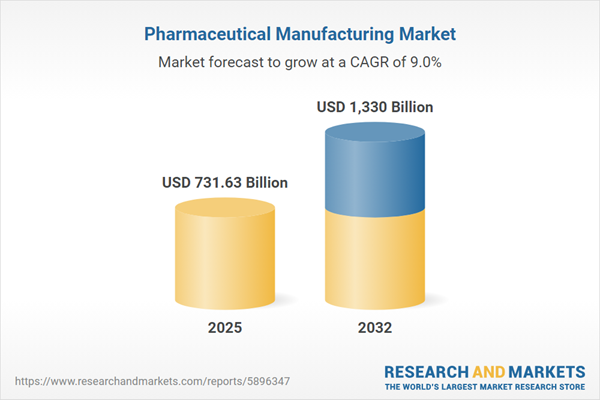Speak directly to the analyst to clarify any post sales queries you may have.
The pharmaceutical manufacturing market faces mounting regulatory complexity, fast-evolving technologies, and significant supply chain shifts. In this environment, executive leaders increasingly depend on actionable, current market intelligence to inform strategic decisions, enhance agility, and secure opportunities.
Market Snapshot: Pharmaceutical Manufacturing Market Overview
The global pharmaceutical manufacturing market is valued at USD 672.44 billion in 2024, with annual growth propelling it to a projected USD 731.63 billion by 2025 and past USD 1.33 trillion by 2032. This growth represents a robust compound annual growth rate (CAGR) of 8.95%. Expansion is driven by ongoing innovation in production processes, rapid adoption of advanced manufacturing technologies, and increased global partnerships. Top market leaders are prioritizing agility and streamlining operations to maintain competitive edge across every stage of manufacturing.
Scope & Segmentation: Strategic Opportunity Map for the Pharmaceutical Manufacturing Market
This report provides in-depth, actionable segmentation tailored for executives to streamline risk management and align business strategies across the pharmaceutical manufacturing value chain. The following segments highlight key operational and market priorities, enabling leadership to capture opportunities and support enterprise objectives:
- Drug Type: Comprehensive analysis covers biosimilars, branded pharmaceuticals, and generics, enabling leaders to diversify portfolios and adapt to market shifts efficiently.
- Dosage Form: Assessment includes liquid, parenteral, and solid forms, facilitating optimal decisions on production investments and evolving patient delivery needs.
- Manufacturing Stage: From API development, formulation, to packaging and labeling, this segment allows a full-scale review that promotes cross-functional collaboration.
- Molecule Type: Evaluation of small molecules alongside biologics sheds light on innovation trends and supports robust therapeutic development pipelines.
- Manufacturing Technology: Detailed review of batch processing, continuous manufacturing, and single-use systems showcases impacts on both scalability and operational cost control.
- End-User: Includes pharmaceutical manufacturers, biotech firms, contract research organizations, government entities, and academics—each group’s distinct contribution spurs market growth and innovation.
- Therapeutic Area: The scope spans cardiovascular, endocrinology, immunology, oncology, rare diseases, neurology, infectious diseases, gastroenterology, and respiratory—supporting informed research prioritization and targeted allocation of resources.
- Regional Coverage: Insights across the Americas, Europe, Middle East, Africa, and Asia-Pacific focus on regulatory demands and localized supply chain strategies for competitive adaptation and compliance.
- Company Profiles: Profiles leading organizations such as Pfizer Inc., Roche Holding AG, Johnson & Johnson, Merck KGaA, Novartis AG, AbbVie Inc., Sanofi S.A., AstraZeneca plc, Eli Lilly and Company, ACG Pvt. Ltd., and Mankind Pharma Ltd., supporting benchmarking and partnership evaluations.
Key Takeaways for Senior Decision-Makers
- Artificial intelligence is actively restructuring production workflows, enabling real-time response to regulatory changes and operational requirements.
- Adoption of single-use technologies fosters greater process flexibility and significantly reduces changeover and downtime between projects.
- Continuous manufacturing methods are enhancing supply chain reliability and compliance with evolving quality benchmarks.
- Rising emphasis on sustainability drives strategic investment decisions as well as supplier selection, aligning with broader corporate social responsibility expectations.
- Firms implementing agile business models achieve faster adaptation to the evolving clinical and regulatory landscape and can more rapidly capture growth opportunities.
- Regional supply chain enhancements, particularly in North America and Asia-Pacific, help ensure more dependable operations and timely market responsiveness.
- Strong partnerships and collaboration with key suppliers are proving critical in fostering innovation and solidifying positioning across the entire value chain.
Tariff Impact: Navigating U.S. Supply Chain Adjustments
Recent U.S. tariff adjustments are compelling pharmaceutical manufacturers to reexamine sourcing approaches and strengthen domestic partnerships. This shift is accelerating nearshoring strategies and driving renewed investment in U.S. production capabilities. Strategic contingency planning is now central in mitigating disruption and protecting ongoing business operations from volatility.
Methodology & Data Sources
This comprehensive analysis draws on both direct interviews with senior industry executives and operational specialists, as well as thorough secondary research from regulatory guidelines, market studies, and key industry reports. This dual-source methodology assures a foundation of reliable insights for board-level planning and enterprise strategy.
Why This Pharmaceutical Manufacturing Market Report Matters
- Empowers executive leadership to enhance manufacturing strategy, maximize capital allocation, and build value throughout the supply chain.
- Delivers actionable segmentation that helps organizations mitigate regulatory complexity and sustain operations amidst disruption.
- Equips decision-makers with forward-looking intelligence to anticipate compliance shifts and industry trends for more resilient risk management.
Conclusion
This report supplies vital, actionable insights for industry leaders seeking to strengthen operational resilience and advance growth initiatives amid ongoing changes in pharmaceutical manufacturing.
Additional Product Information:
- Purchase of this report includes 1 year online access with quarterly updates.
- This report can be updated on request. Please contact our Customer Experience team using the Ask a Question widget on our website.
Table of Contents
3. Executive Summary
4. Market Overview
7. Cumulative Impact of Artificial Intelligence 2025
Companies Mentioned
The companies profiled in this Pharmaceutical Manufacturing market report include:- Pfizer Inc.
- Roche Holding AG
- Johnson & Johnson
- Merck KGaA
- Novartis AG
- AbbVie Inc.
- Sanofi S.A.
- AstraZeneca plc
- Eli Lilly and Company
- ACG Pvt. Ltd.
- Mankind Pharma Ltd.
Table Information
| Report Attribute | Details |
|---|---|
| No. of Pages | 185 |
| Published | October 2025 |
| Forecast Period | 2025 - 2032 |
| Estimated Market Value ( USD | $ 731.63 Billion |
| Forecasted Market Value ( USD | $ 1330 Billion |
| Compound Annual Growth Rate | 8.9% |
| Regions Covered | Global |
| No. of Companies Mentioned | 12 |









